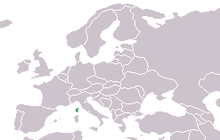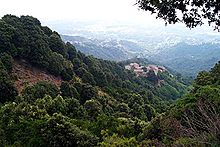- Corsican Fire Salamander
-
Corsican Fire Salamander 
Conservation status Scientific classification Kingdom: Animalia Phylum: Chordata Class: Amphibia Order: Caudata Family: Salamandridae Genus: Salamandra Species: S. corsica Binomial name Salamandra corsica
Savi, 1838Synonyms Salamandra salamandra ssp. corsica Savi, 1838
The Corsican Fire Salamander (Salamandra corsica) is a species of salamander in the Salamandridae family. It is found only on the island of Corsica as an endemic species. For former times this species was known as a subspecies of the widespread but continental distributed Fire salamander which may appear quite similar.
Contents
Habitat
The Corsican Fire Salamander mainly lives in the deciduous mountain forests of the island. On the west coast near in the Calanques de Piana Salamanders have been found near sea level but in general they appear as inhabitant of forests with deciduous oaks like Sessile, Downy Oak and Sweet Chestnut gardens near the human settlements. Forrests with the Maritime Pine and the Corsican Black Pine (Pinus nigra subsp. salzmannii var. corsicana are also inhabitated. Densly growing frens (i.g. Pteridium aquilinum), Tree Heath and other shrubby vegetation might deminish the Fire Salamander population, also as evergreen sclerophyllic woods like holly oak forests because of their minor precipitation sum. Beech forests are populated in the Castagniccia and also in the south of the island where this tree assembles dense azonal forests and does not appear mainly as upper Tree line like i.g. in the western mountain ranges of Corsica.
The mid ranges of the corsican mountains seem to be prefered because of their constant humidity and moderat temperatures. Constant water in the creeks coming down from the summits support good development of the larvae over the hot summer. They are born when the snow has melted away and the streams are safe again for the newborn unskillful larvae. Their surrounding and stone runs offer also to the adults prefered places to hide away from the daylight or the summer drought.
Unexpected ways of reproduction
The german herpetologist Robert Mertens found a pregnant Corsican Fire Salamander in the Restonica valley that gave birth to four offsprings without gills and already with the charcteristic black and yellow of the adults. At the same time he found normally developing aquatic larvae with their three characteristic feathery external gills on each side of the heads and camouflage blending on the pond's ground. The astonishing reproductive ability of vivipary is well known from the Fire Salamander's nortwest spanish subspecies Salamandra salamandra ssp. bernardezi (Asturian Fire Salamander) and Salamandra atra (Alpine Salamander) from the central and east Alps. This can be interpreted as a local adaptation to xerothermic climate conditions and lack of ponds an brooks.
Threats
The Corsican Fire Salamander is threatened by habitat loss, forest works, road constructions and roadkill. The species may also be threatened by water pollution, wildfires and wood pasture. Introducing invasive fish species like Rainbow trouts in the larvae's habitats deminishes the reproduction of the Island's Fire salamanders singnificantly. Indigenous anadromous fish like the Mediterranean trout Salmo cettii which is also highly endangered seems not to have that big influence on the amfibians.
References
- Michel Delaugerre, Marc Cheylan: Atlas de Repartition des Batraciens et Reptiles de Corse. Parc Naturel Regional de Corse/Ecole Pratique des Hautes Etudes, L'Oikéma Pamplona (Spain), o. O. 1992, ISBN 2-905468-09-2.
- Robert Mertens: Die Amphibien und Reptilien Korsikas – Senckenberg. Biol. 38 (1957, Heft 3/4): 175–192, Frankfurt/M.
- Miaud, C. 2004 Salamandra corsica. 2006 IUCN Red List of Threatened Species. Downloaded on 9 July 2007.
- Thomas Mutz: Salamandra corsica (Savi, 1838) – Korsischer Feuersalamander. – In: Burkhard Thiesmeier & Kurt Grossenbacher (Eds.): Handbuch der Reptilien und Amphibien Europas, Schwanzlurche IIB. Aula Verlag Wiebelsheim (Germany), 2004, p. 1029–1046.
- Willi Wolterstorff: Streifzüge durch Corsika. Faber’sche Buchdruckerei, Magdeburg 1901, 35 p.
External links
Categories:- IUCN Red List least concern species
- Amphibians of Europe
- Salamandridae
Wikimedia Foundation. 2010.



